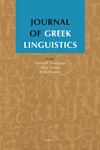
When I returned home after SBL a package was awaiting me from CARDDIA entitled Biblical Greek Alphabet. Angelo Cheung, the producer of these cards had offered to send them to me several weeks ago so that I could give my assessment of them on this blog. I was delighted to see them and opened the package right away. Let’s start with a description of what the cards provide.
The set includes forty-eight alphabet cards, 24 upper case and 24 lower case, plus eleven additional cards covering diacritics and punctuation. Each alphabet card provides the target letter in an attractive large font on one side and key information about that letter on the back, including guidance on the stroke sequence needed to write the letter, the letter’s alphabetical order, its Greek name, the form not shown on the front (upper case for lower case letters, lower case for upper case letters), the usual English transliteration, a pronunciation suggestion, and one or more forms of the letter found in manuscripts. This last detail is a welcome addition to what such products usually provide.

Punctuation and diacritics cards show the relevant mark with a gray letter or word on the front of the card and give an explanation on the back.

Each card is 8.6 centimeters (almost 3.5 inches) across and 6.1 centimeters (almost 2.5 inches) tall. The clear print allows a surprisingly large amount of information to be legibly presented in this small space.
When the producers of the cards first contacted me about writing a review, the cards gave pronunciation suggestions using the Erasmian system, and I recommended that they revise them to provide the reconstructed Hellenistic pronunciation. They have clearly attempted to do this, but with mixed results. The card for β recommends “v as in vote” which does pretty well approximate the Hellenistic pronunciation of that letter, but the recommendation for τ is “t as in time,” and this aspirated pronunciation was not in fact used. The letter was pronounced like the “t in stand” where there is no aspiration. The card for ζ even retains the Erasmian recommendation!
The discussion of accents is particularly problematic as the editor has merged pitch accent with stress accent. The recommendation for the acute, for example, is as follows:
The acute is used to indicate a syllable with a high pitch, it marks the stressed vowel of a word. (e.g. χρόνος)
Pitch accent had disappeared before the period of “Biblical Greek” and mixing the two systems is simply confusing.
My recommendation to students who use any such cards along with a course in Greek is to ignore the pronunciation recommendations and listen to your instructor. It is the other features of the cards that are particularly useful anyway, and the quality of production of this set places it above any other I have seen.
 Louis Sorenson has produced a nice reading of the first nine chapters of Mark’s Gospel following Westcott and Hort’s 1881 text using the Restored Koine pronunciation. His Let’s Read Greek website has numerous helpful resources for reading Greek texts. This is one among many.
Louis Sorenson has produced a nice reading of the first nine chapters of Mark’s Gospel following Westcott and Hort’s 1881 text using the Restored Koine pronunciation. His Let’s Read Greek website has numerous helpful resources for reading Greek texts. This is one among many.
 Steven E. Runge and Christopher J. Fresch have edited the papers from the Greek Verb Conference in Cambridge last year into a new volume entitled
Steven E. Runge and Christopher J. Fresch have edited the papers from the Greek Verb Conference in Cambridge last year into a new volume entitled 



